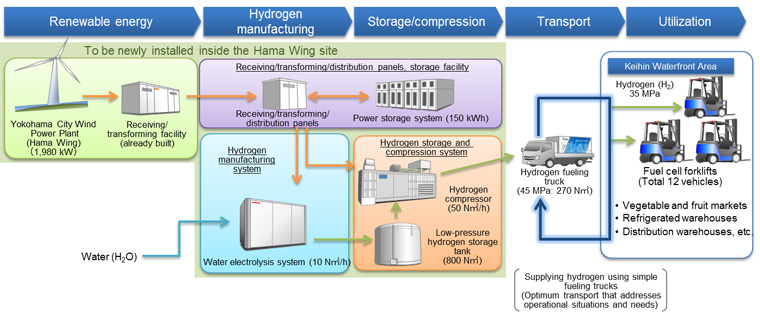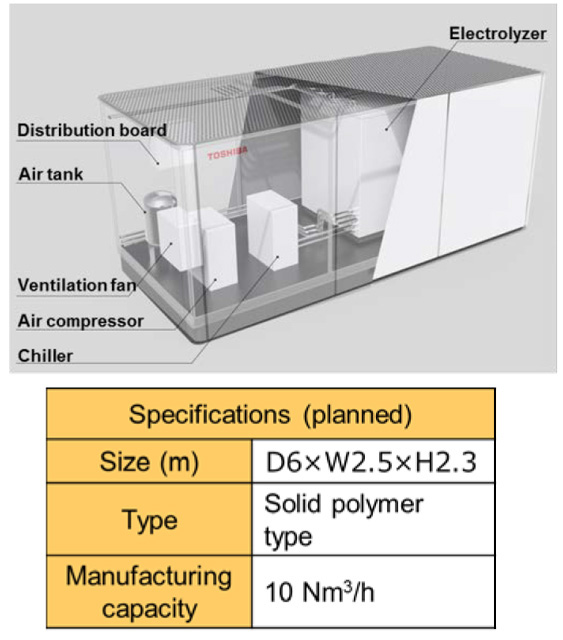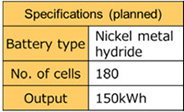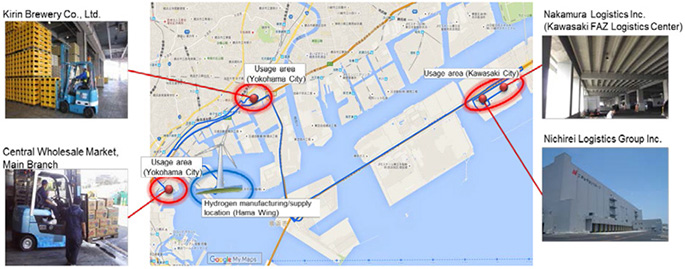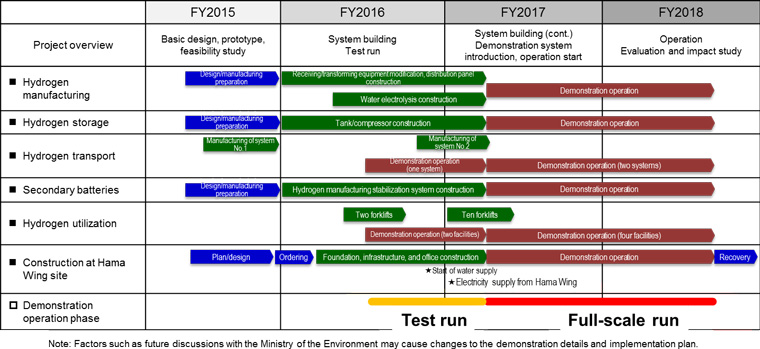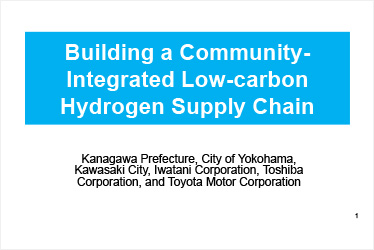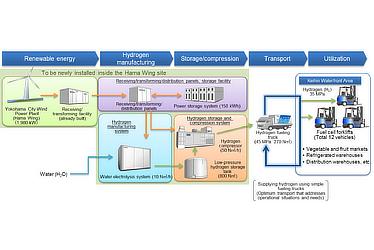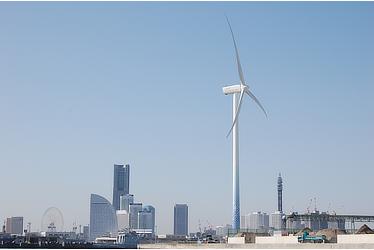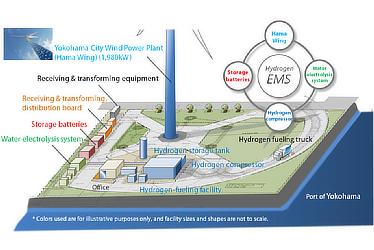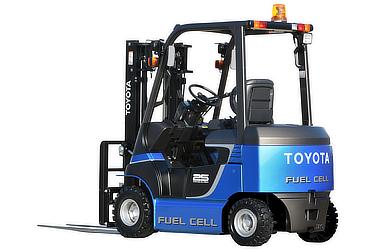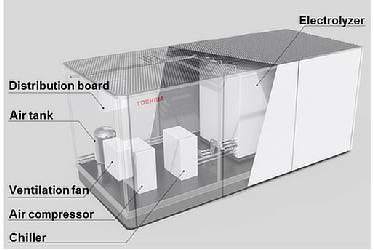Mar. 14, 2016
City of Yokohama
Kawasaki City
Iwatani Corporation
Toshiba Corporation
Toyota Motor Corporation
Public-Private Partnership to Test End-to-End Hydrogen Supply Chain
A Japanese partnership, consisting of the Kanagawa Prefectural Government, the municipal governments of the cities of Yokohama and Kawasaki, and three private sector companies, today announced the forthcoming start of a project to implement and evaluate an end-to-end low-carbon hydrogen supply chain which will use hydrogen produced from renewable energy to power forklifts. Announced last September, the project will be carried out at facilities along Tokyo Bay in Yokohama and Kawasaki, with support from Japan's Ministry of the Environment.
Electricity generated at the Yokohama City Wind Power Plant (Hama Wing) will be used to electrolyze hydrogen that is compressed, stored, and then transported in a hydrogen fueling truck to four sites: a factory, a vegetable and fruit market, and two warehouses. At these locations, the hydrogen will be used in fuel cells to power forklifts operating in diverse conditions.
This low-carbon hydrogen supply chain is expected to reduce CO2 emissions by at least 80 percent compared with a supply chain using forklifts powered by gasoline or grid electricity. The project's aim is to establish a hydrogen supply chain, investigate costs, and estimate potential CO2 reductions that can be achieved with a full-fledged supply chain in the future.
Project Overview
- System to produce hydrogen by electrolyzing water using wind power
- System to optimize storage and transportation of hydrogen
- Use of fuel cell forklifts
- Hydrogen supply chain feasibility study
Project System Flow
Main Characteristics of Demonstration Project
- System to produce hydrogen by electrolyzing water using wind power
- Hydrogen will be produced using renewable energy generated at Hama Wing to operate a water electrolysis system.
- The management system will enable flexible, CO2-free, hydrogen production that accounts for temporary discrepancies between power output and hydrogen demand.
- System to optimize storage and transportation of hydrogen
- Sufficient hydrogen to power fuel cells for two days will be stored onsite.
- Electricity will also be stored in an environmentally-friendly storage battery system that re-uses batteries from hybrid vehicle batteries, thus ensuring a stable hydrogen supply even when Hama Wing is not operational.
-
- Storage Battery System (Toyota Turbine and Systems Inc.)
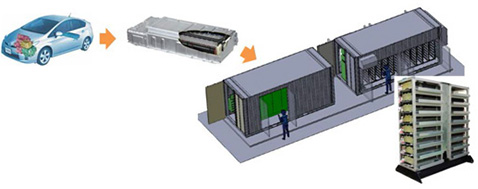
-
- The hydrogen will be compressed for use in forklifts, and delivered in hydrogen fueling trucks (the first of their kind to be used in Japan).
- The consumption of hydrogen by the forklifts will be constantly monitored, so as to ensure optimal transportation and supply to meet user needs.
- Use of fuel cell forklifts
- Twelve forklifts will operate at the four selected locations to demonstrate their viability in a range of operating conditions.
- Japan's first fuel cell powered forklifts, which Toyota introduced in February 2016, emit zero CO2 during operation.
-
- Fuel Cell Forklift
(Toyota Industries Corporation) 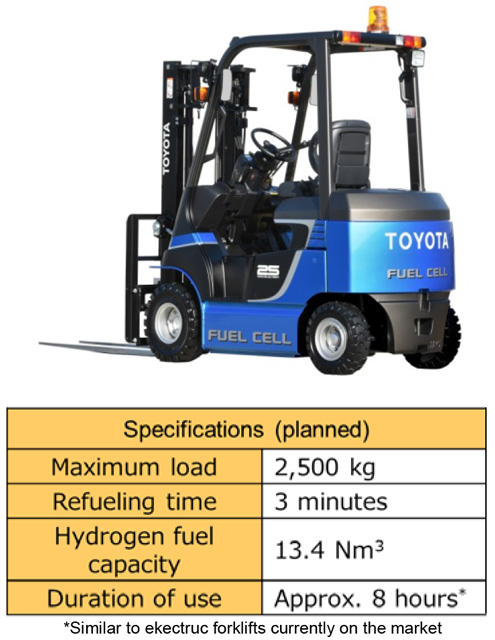
- Fuel Cell Forklift
-
- Hydrogen supply chain feasibility study
- The demonstration project will provide data for assessing future courses of action required to reduce hydrogen costs, including the establishment of a mass production process, and the steps needed to implement deregulation.
- It will also contribute to discussions on developing a model for promoting the adoption of hydrogen through technological innovation, and the development of full-fledged supply chains, based on projections of needs in 2030.
- The project will focus on reducing CO2 emissions, with current estimates suggesting that the establishment of this low-carbon supply chain will reduce emissions by at least 80 percent (compared with a supply-chain using forklifts powered by gasoline or grid electricity).
- The project will also promote the investigation of methods to further reduce CO2 emissions.
Schedule
- Following a preparatory period, trial operations of the project are scheduled to begin in this autumn, with the introduction of a single forklift at two facilities, and the initiation of the hydrogen delivery system using hydrogen refueling trucks.
- Full-scale operations will start in FY2017, when a total of 12 forklifts will be deployed―three each at four facilities. During this time, the entire system will start operating―including production, storage, compression, delivery and use of hydrogen.




